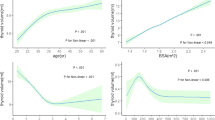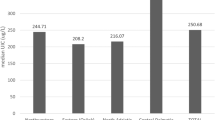Abstract
Goiter prevalence in school-age children and median urinary iodine concentration (UIC) are the main indicators of iodine deficiency in a population. In areas of mild iodine deficiency, where goiters are small, ultrasound is preferable to physical examination to estimate goiter prevalence. The World Health Organization (WHO) has adopted thyroid volume ultrasonography results from a survey of European schoolchildren as an international reference, but these values have recently been questioned. The aims of the study were: a) to determine regional normal echo-graphic reference values of thyroid volume in children aged between 11 and 14 yr in the Veneto Region, in North-East Italy; b) to determine goiter prevalence by physical and ultrasonographic examination; c) to determine UIC in this section of the population. A cross-sectional study was carried out on 1730 schoolchildren, aged between 11 and 14, living in towns in low-lying areas, in the valleys of the pre-Alps and in the mountains between 600 and 1200 m. Thyroid volume was evaluated by inspection and palpation using the WHO criteria. In 560 children thyroid volume was determined by ultrasound. UIC was measured in 1368 children. On physical examination a grade I goiter was found in 7.5% of children. No goiter grade II or grade III was found. The regional thyroid volume reference values by ultrasonography were similar, or slightly lower (5–20%), to the corresponding WHO reference values. Mean UIC was 148±110 μg/l, with no difference between lowlands and uplands; UIC values less than 100 μg/l were found in about 30–35% of the children. UIC was higher in children using iodized salt than in non-users. No correlation was found between thyroid volume by ultrasonography and UIC. Thyroid volume was found to be bigger in upland children than in those in low-lying areas, probably because of low iodine intake in people living in the mountains in previous generations. This data show that Veneto is not a iodine-deficient area, with no presence of endemic goiter. However, the great number of children with a UIC of less than 100 μg/l also suggests the use of iodized salt in the Veneto Region.
Similar content being viewed by others
References
Delange F, Dunn JT, Glinoer D. Iodine deficiency in Europe. A continuing concern. New York: Plenum Press 1993.
Perez C, Scrimshaw S, Muniz A. Technique of endemic goiter surveys. In: Endemic goiter. Geneva: WHO. 1960, 369–83.
WHO, UNICEF, ICCIDD. Indicators for assessing iodine deficiency disorders and their control through salt iodization. WHO/NUT/ 94.6. Geneva: WHO 1994.
Rasmussen SN, Hjorth L. Determination of thyroid volume by ultrasonic scanning. J Clin Ultrasound 1974, 2: 143–7.
Berghout A, Wiersinga WM, Smits NJ, Touber JL. Determination of thyroid volume as measured by ultra-sonography in healthy adults in a non-iodine deficient area. Clin Endocrinol (Oxf) 1987, 26: 273–80.
Lisboa HK, Gross JL, Orssolin A, Fuchs S. Clinical examination is not an accurate method of defining the presence of goitre in Schoolchildren. Clin Endocrinol (Oxf) 1996, 45: 471–5.
Vitti P, Martino E, Lombardi FA, et al. Thyroid volume measurement by ultrasound in chidren as a tool for assessment of mild iodine deficiency. J Clin Endocrinol Metab 1994, 79: 600–3.
Delange F, Benker G, Caron P, et al. Thyroid volume and urinary iodine in European schoolchildren: standardization of values for assessment of iodine deficiency. Eur J Endocrinol 1997, 136: 180–7.
WHO/ICCIDD. Recommended normative values for thyroid volume in children age 6–15 years. Bulletin WHO 1997, 75: 95–7.
Foo LC, Zulfiqar A, Nafikudin M, Fadzil MT, Asmah ASA. Local versus WHO/ICCIDD-recommended thyroid volume reference in the assessment of iodine deficiency disorders. Eur J Endocrinol 1999, 140: 491–7.
Squatrito S, Delange F, Trimarchi F, Lisi E, Vigneri R. Endemic Cretinism in Sicily. J Endocrinol Invest 1981, 4: 295–302.
Cabassa N, Franzelin F, Testini L. Il gozzo in Alto Adige. Bolzano: Officine Grafiche Athesia 1984.
Oberofer R, Ober A, Amor H. Goiter epidemiology in South Tyrol. Dtsch Med Wochenschr 1992, 40: 508–12.
Fenzi GF, Aghini-Lombardi F, Biusti LF, Marcocci C, Pinchera A. Epidemiological studies on endemic goiter and IDD in Tuscany, Italy. IDD Newsletter 1986, 2: 8–11.
Salvi M, Gardini E, Minelli R, et al. Iodine deficiency in schoolchildren of the province of Parma, Italy. J Endocrinol Invest 1989, 12: 651–2.
Marena C, Vailati A, Fedele P, et al. Inchiesta sul gozzismo in età scolare primaria nelle valli Bisogno e Trebbia (Appennino Ligure-Emiliano). Minerva Medica 1990, 81: 637–40.
Martino E, Loviselli A, Velluzzi F, et al. Endemic goiter and thyroid function in Central-Southern Sardinia: Report on an extensive epidemiological survey. J Endocrinol Invest 1994, 17: 653–7.
Aghini-Lombardi F, Antonangeli L, Vitti P, Pinchera A. Status of iodine nutrition in Italy. In: Iodine deficiency in Europe. A continuing concern. New York: Plenum Press. 1993, 403–8.
Aghini-Lombardi F, Pinchera A, Antonangeli L, et al. Iodized salt prophylaxis of endemic goiter: an experience in Toscana (Italy). Acta Endocrinol (Copenh) 1993, 129: 497–500.
Aghini-Lombardi F, Antonangeli L, Pinchera A, et al. Effect of iodized salt on thyroid volume of children living in an area previously characterized by moderate iodine deficiency. J Clin Endocrinol Metab 1997, 82: 1136–9.
Aghini-Lombardi F, Antonangeli L, Martino E, et al. The spectrum of thyroid disorders in an Iodine-Deficient community: the Pescopagano survey. J Clin Endocrinol Metab 1999, 84: 561–6.
Frigato F, Cerisara D, DeVido D, et al. Epidemiological survey of goiter and iodine deficiency in Veneto region. J Endocrinol Invest 1996, 19: 734–8.
Hegedus L, Perrild H, Poulsen L, et al. Determination of thyroid volume by ultrasound and its relationship to body weight, age and sex in normal subjects. J Clin Endocrinol Metab 1983, 56: 260–3.
Hess SY, Zimmermann MB. Thyroid volumes in a national sample of iodine-sufficient Swiss schoolchildren: Comparison with the World Health Organization/International Council for the control of Iodine deficiency disorders normative thyroid volume criteria. Eur J Endocrinol 2000, 142: 599–603.
Xu F, Sullivan K, Houston R, Zhao J, May W, Maberly G. Thyroid volumes in US and Bangladeshi schoolchildren: comparison with European schoolchildren. Eur J Endocrinol 1999, 140: 498–504.
Fleury Y, Van Melle G, Woringer V, Gaillard RC, Portmann L. Sex-dependent variations and timing of thyroid growth during puberty. J Clin Endocrinol Metab 2001, 86: 750–4.
Ivarsson SA, Persson PH, Ericsson UB. Thyroid gland volume as measured by ultrasonography in healthy children and adolescent in a non-iodine deficient area. Acta Paediatr Scand 1989, 78: 653–4.
Dunn JT. Endemic goiter and cretinism: an update on iodine status. J Pediatr Endocrinol Metab 2001, 14: 1469–73.
Menkel KU, Engelhardt S, Olbritc T. Thyroid gland volume and urinary iodine excretion in children 2–16 years of age. Dtsch Med Wochenschr 1992, 117: 1047–51.
Semiz S, Senol U, Bircam O, et al. Thyroid gland volume and urinary iodine excretion in children 6–11 years old in an endemic area. J Pediatr Endocrinol Metab 2000, 13: 245–51.
Nigaard B, Gideon P, Dige-Peterson H, Jespersen N, Sølling K, Veje A. Thyroid volume and morphology and urinary iodine excretion in a Danish Municipality. Acta Endocrinol (Copenh) 1993, 129: 505–10.
Bürgi H, Portmann L, Podoba J, Vertongen F, Srbecky M. Thyroid volumes and urinary iodine in Swiss school children, 17 years after improved prophylaxis of iodine deficiency. Eur J Endocrinol 1999, 140: 104–6.
Author information
Authors and Affiliations
Corresponding author
Rights and permissions
About this article
Cite this article
Busnardo, B., Nacamulli, D., Frigato, F. et al. Normal values for thyroid ultrasonography, goiter prevalence and urinary iodine concentration in schoolchildren of the Veneto Region, Italy. J Endocrinol Invest 26, 991–996 (2003). https://doi.org/10.1007/BF03348197
Accepted:
Published:
Issue Date:
DOI: https://doi.org/10.1007/BF03348197




